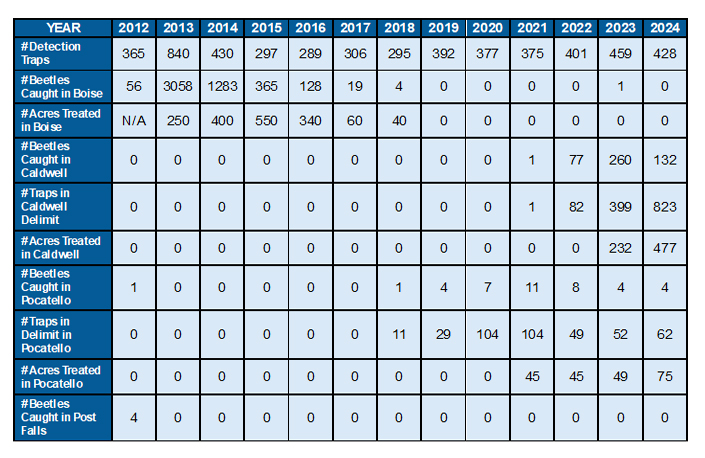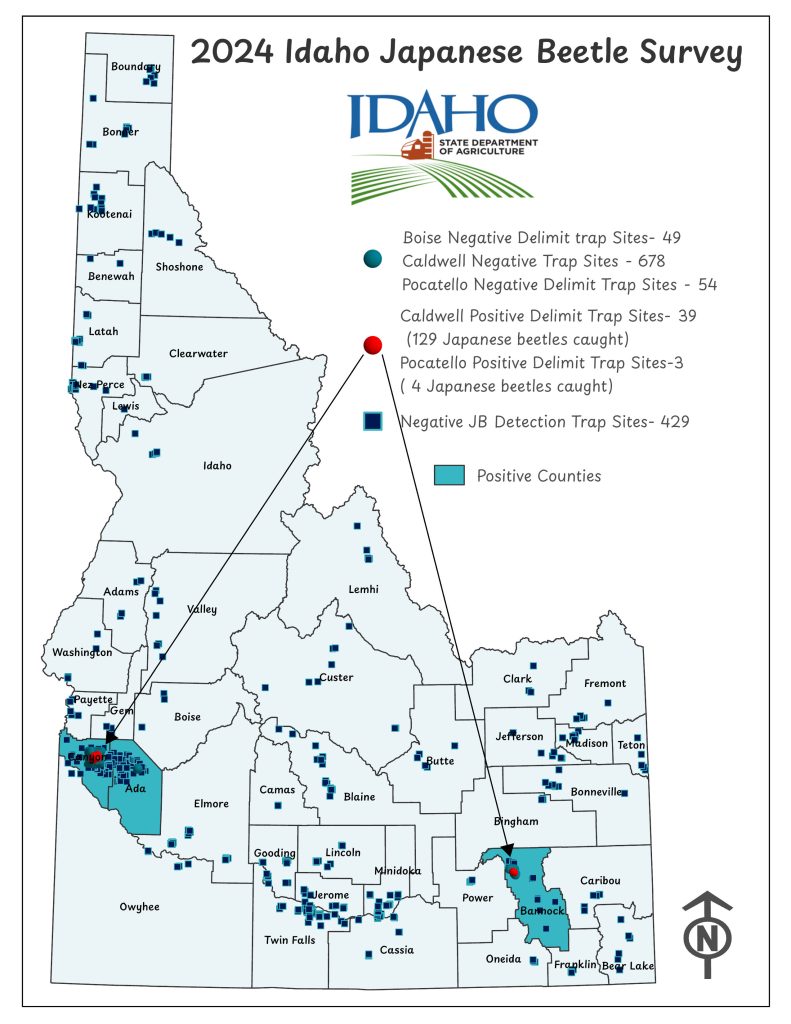Japanese beetles (Popillia japonica) are highly invasive pests of more than 300 plants including some of Idaho’s top commodities. ISDA is currently implementing Japanese beetle eradication plans in two areas of Idaho (Caldwell and Pocatello).
Caldwell Eradication Program
- 2021 – One detection trap in Caldwell, collected the first Japanese beetle specimen ever found in Canyon County.
- 2022 – 82 JB traps were set up in Caldwell. Between July and September, 77 Japanese beetle were collected in the traps, defining an established infestation that appears to be centered in a residential area bordered by Lincoln Rd (N), Franklin Rd (S), I-84 (W) and Smeed Pkwy (E).
- 2023 – 1,065 properties and 310 acres of turf were treated for Japanese beetles in Caldwell. Traps in Caldwell collected 260 Japanese beetles, indicating the infestation has expanded.
- 2024 – The Caldwell treatment zone has expanded, and two rounds of Japanese beetle treatment are planned, with 477 acres were treated and throughout the season 132 beetles were found indicating the treatments have been effective in cutting the population of invasive beetles down by half.
- 2025 – Treatments will continue in the residential and commercial areas the beetles were found to continue the trend of lowering the population.
Pocatello Eradication Program
- 2018 – One detection trap in Pocatello, collected a single Japanese beetle specimen in Bannock, County.
- 2019 – 29 JB traps were set up around the single positive in Pocatello. Between July and September 4 Japanese beetles were collected in the traps. Locations of the positive traps were one east of I-15, Ross Park, Riverside Golf Course and off S Grant Ave.
- 2020 – 104 JB traps were set out to define just where our infestation was located. Between July and September 7 Japanese beetles were collected in two separate traps one located near Centennial Park and the other positive trap was located at Ross Park.
- 2021 – 104 JB traps were set up and between July and September we collected 11 Japanese beetles. 8 JB were caught in the two traps placed at Centennial Park, 1 JB off Grant Ave, 1 JB near Ross Park and 1JB was caught on the ISU campus. ISDA and Pocatello’s Parks and Recreation treated 45 acres between Centennial Park and Ross Park.
- 2022 – 49 traps were set up around the area of concern. 8 Japanese beetles were collected in two traps at Ross Park. ISDA and Pocatello’s Parks and Recreation treated 45 acres between Centennial Park and Ross Park.
- 2023 – 52 traps were set up and 4 Japanese beetles were collected between July and September. ISDA and Pocatello’s Parks and Recreation treated 49 acres between Centennial Park and Ross Park and the Visitor Information Center located on S 5th.
2024 – 62 traps were set up and 4 Japanese beetles were collected between July and September. ISDA and Pocatello’s Parks and Recreation treated 75 acres between Taysom Park and Ross Park and the Visitor Information Center located on S 5th. - 2025 – The Pocatello treatment areas have expanded, and two rounds of Japanese beetle treatment are planned. ISDA will set up 117 JB traps in the area this year to make sure that we are not missing any other infestations in the Pocatello area.
- Japanese beetles are ½ to ¾ inch long.
- Front of body is shiny metallic green. Wing cases are coppery.
- Body has 5 white tufts of hair along each side.
- Adult beetles feed on the upper leaf surface, removing leaf tissue and releasing an aggregation pheromone that attracts additional beetles to the potential food source.
- Manifested as skeletonized leaves with large, irregular holes, adults will move to devour flowers and fruits.
- Evidence of grub (beetle larva) are often unnoticed until populations build up to levels of sufficient to kill grass roots.
- Evidence of damage is seen when localized discolored patches appear.
- Attracted to some of Idaho’s top commodities including hops, grapes, apples, stone fruits, vegetable crops, and nursery stock.
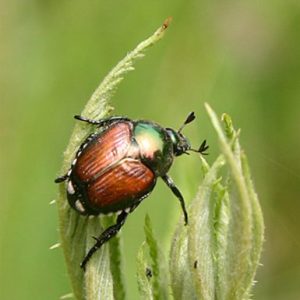
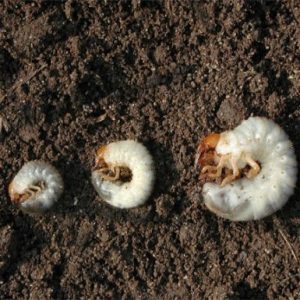
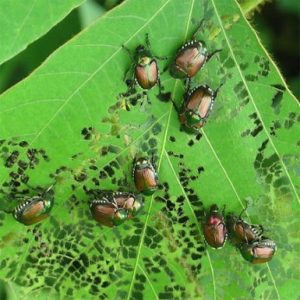
Caldwell
- An established infestation that appears to be centered in a Caldwell residential area bordered by Lincoln Rd (N), Franklin Rd (S), I-84 (W) and Smeed Pkwy (E).
Pocatello
- In Pocatello beetles have been caught South of (E) Center St to Ross Park on (S) 2 Ave. below South Valley Rd. over to Bannock Hwy near Riverside Golf Course, and North to (S) Grant Ave to Centennial Park and Rainey Park.
Caldwell and Pocatello residents in treatment areas:
- Complete the consent form and return to ISDA by email jb@isda.idaho.gov by April 18, 2025.
- Be on the look out for a notification about treatment, approximately one week before the pesticide application.
Others:
- Look out for signs of Japanese beetle (see “Identifying Japanese Beetles”).
- Report any signs of Japanese beetle to ISDA at JB@ISDA.Idaho.Gov and please provide pictures if you are able.
See the resources below for more information on Japanese beetles in Idaho.
- Pollinator Protection – The Idaho State Department of Agriculture takes extensive measures to ensure that all insect eradication efforts have minimal impact on bees and other pollinators.
- Pesticides Used:
- May application – Granular Insecticide Acelepryn G – active ingredient chlorantraniliprole, is classified by the U.S. Environmental Protection Agency as a reduced-risk pesticide. It has the lowest relative toxicity compared to other insecticides labeled for the same purpose.
- Mid-July application – Granular Insecticide Imidacloprid – developed to mimic nicotine which is a naturally occurring compound found in many plants, including tobacco, and is very toxic to insects. Possible hazards to pollinators exist with residue in leaves and blossoms of treated plants. When applied only to turfgrass, strictly adhering to label directions, this neonicotinoid-class pesticide can eliminate the JB grub without harming bee and pollinator health and will remain a critical tool in the eradication effort (National Pesticide Information Center (NPIC), 2010).
“Though these products have excellent safety records with the intended action plan use, ISDA will be taking extraordinary measures to ensure that pesticide applications have minimal impact on residents and the environment.”
Caldwell Treatment Area
- A total of 320 acres of treatable turf is planned for Caldwell in 2025
- 3 properties owned by City of Caldwell 180 acres (estimated 100 acres treatable turf)
- 1,180 residential or commercial properties 400 acres (estimated 200 acres treatable turf)
- 4 school properties 40 acres (estimated 20 acres treatable turf)
- Residents will be notified at least 1 week in advance of any treatment.
- May application – Granular Insecticide Acelepryn G.
- Mid-July application – Granular Insecticide Imidacloprid.
- Each treatment area will take one week but the application of larvicide to each property only takes about 15 minutes.
Pocatello Treatment Area
- A total of 105 properties and 75 acres of treatable turf is planned for Pocatello in 2025
- 18 properties owned by City of Pocatello 217 acres (estimated 54 acres treatable turf)
- 69 residential properties 17 acres (estimated 4 acres treatable turf)
- Residents will be notified at least 1 week in advance of any treatment.
- May application – Granular Insecticide Acelepryn G.
- Mid-July application – Granular Insecticide Imidacloprid.
- Each treatment area will take one week but the application of larvicide to each property only takes about 15 minutes.
If not properly eliminated, Japanese beetles have potential to be destructive to Idaho’s agriculture industry.
- The industry would suffer losses due to decreased production of marketable fruit and plant products, increased pesticide use, and loss of markets if other states or countries enacted quarantines against Idaho products.
- Western states and foreign countries could impose quarantine restrictions on movement of Idaho’s top agricultural commodities including hop, apple, grape, stone fruit, vegetable seed, and nursery stock.
Pre-Treatment:
1) Your property is accessible to the contractor’s crew. All applicable outside gates and entryways should be unlocked, and animals must be kept inside.
2) Non-stationary items that can be easily moved should be removed from lawns and grassy areas.
3) Water and food bowls for pets should be removed or covered during application.
4) Adults, children and pets of all kinds should remain inside during the application.
Note: Koi ponds and all water features containing fish or other aquatic animals should be tightly covered immediately before application. The cover should be removed immediately after the treatment is completed.
Post-Treatment:
- Thoroughly water lawn and grassy area on your property where the granular turf treatment has been applied to allow it to penetrate the soil where the grubs are feeding.
- After the turf treated areas are watered, allow to dry completely.
- Once the area is dry, people and pets may safely re-enter/ resume normal activities.
*Please use an automated sprinkler or garden hose to water in the granular treatment, DO NOT flood irrigate.
Statewide Monitoring and Treatment Results
